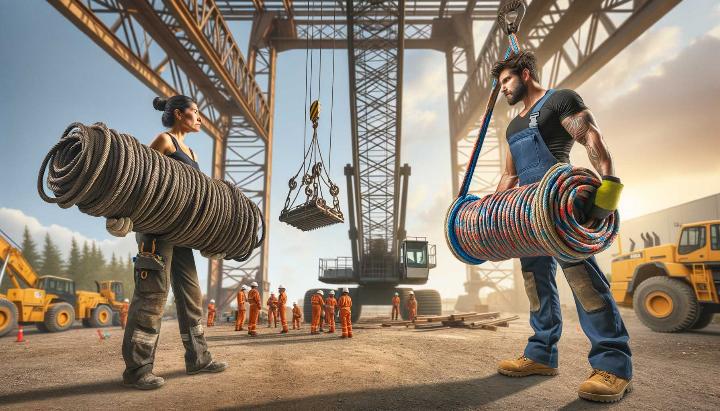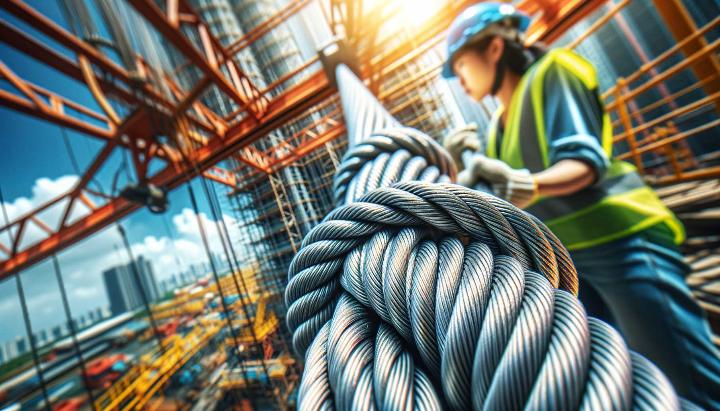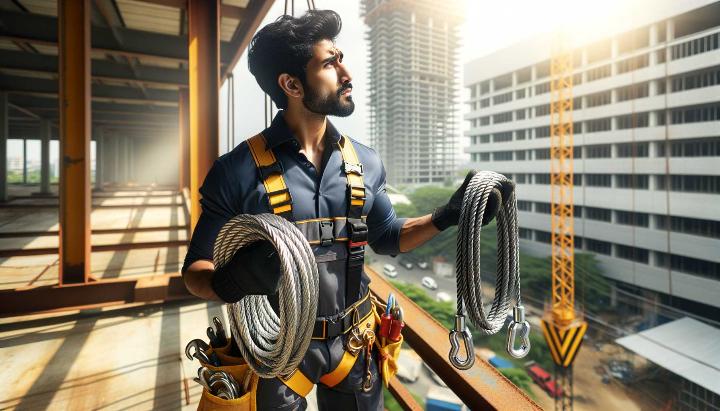Have you ever wondered why some construction sites seem to effortlessly lift massive loads while others struggle with even the simplest rigging tasks? The secret lies in choosing the right sling and rigging solutions. In an industry where safety and efficiency are paramount, the debate between traditional wire rope and modern high-performance slings has never been more relevant.
Imagine this: a critical lift operation where every second counts, and the margin for error is razor-thin. Would you trust your team's safety and your project's success to outdated technology? That's the dilemma many industry professionals face today, but it doesn't have to be this way.
In this eye-opening comparison, we'll delve into the world of wire rope sling rigging and explore how innovative solutions from companies like iRopes are revolutionising the industry. We'll uncover why these modern sling and rigging alternatives are not just safer and more versatile, but also surprisingly more cost-effective than traditional wire rope and rigging methods.
Get ready to challenge your preconceptions and discover how the right choice in rigging solutions can transform your operations, boost safety, and significantly impact your bottom line. Whether you're a seasoned professional or new to the field, this guide will equip you with the knowledge to make informed decisions that could redefine your approach to lifting and rigging.
Understanding Wire Rope Sling Rigging
When it comes to lifting heavy loads, wire rope sling rigging is a crucial component in many industries. As someone who's spent years in the field, I've seen firsthand how proper understanding and implementation of wire rope slings can make or break a project. Let's dive into the world of wire rope sling rigging and explore its key aspects.
Components and Construction of Wire Rope Slings
Wire rope slings are marvels of engineering, designed to handle immense loads with precision. They consist of three main components:
- Wires: The building blocks of the rope, typically made of high-strength steel.
- Strands: Groups of wires twisted together in a specific pattern.
- Core: The central part of the rope, which can be made of fibre or steel.
The way these components are arranged determines the rope's properties. For instance, a 6x19 construction (6 strands with 19 wires each) offers a good balance of strength and flexibility, making it ideal for general-purpose lifting.

Safe Rigging Techniques for Wire Rope Slings
Safety is paramount when working with wire rope slings. One critical factor to consider is the sling angle. The wider the angle between the sling legs, the greater the stress on each leg. This is where the "sling angle factor" comes into play.
For example, a 60-degree sling angle reduces the sling's capacity to 86.6% of its rated capacity. Always remember the golden rule: never exceed a 60-degree angle between sling legs unless specifically designed for wider angles.
Calculating Wire Rope Sling Capacities
Accurate load calculation is crucial for safe lifting operations. The formula for calculating the tension in each leg of a two-leg sling is:
Tension = (Load Weight) / (2 x cosine of sling angle)
Remember, this is just a starting point. Always consult manufacturer guidelines and factor in safety margins when determining load capacities.
Understanding wire rope sling rigging is essential for safe and efficient lifting operations. While wire rope slings offer tremendous strength and durability, they also come with limitations. In the next section, we'll explore how modern sling and rigging solutions, like those offered by iRopes, can provide cost-effective alternatives with enhanced safety features and versatility.
Modern Sling and Rigging Solutions: Revolutionizing Industrial Lifting
As someone who's been in the rigging industry for over two decades, I've witnessed firsthand the remarkable evolution of sling and rigging technology. Gone are the days when wire rope was the only go-to solution for heavy lifting. Today, modern sling and rigging solutions are transforming the way we approach industrial lifting, offering a plethora of advantages that make them increasingly appealing alternatives to traditional wire rope.
Synthetic Slings: The Lightweight Champion of Versatility
One of the most significant game-changers in the industry has been the introduction of synthetic slings. These marvels of engineering have revolutionised our approach to lifting, offering a combination of strength and flexibility that wire rope simply can't match.
- Impressive strength-to-weight ratio: Synthetic slings can lift loads comparable to wire rope at a fraction of the weight, reducing fatigue and improving worker safety.
- Unparalleled flexibility: Their ability to conform to irregular loads makes them ideal for delicate or oddly shaped items.
- Corrosion resistance: Unlike wire rope, synthetic slings don't rust, making them perfect for marine environments or chemical plants.
I remember a project where we needed to lift a series of delicate sculptures for an art installation. The synthetic slings we used allowed us to cradle each piece securely without risking damage - something that would have been nearly impossible with rigid wire rope.
Advanced Rigging Technology: Precision and Safety in Every Lift
It's not just about the slings themselves; the entire rigging ecosystem has undergone a technological revolution. Modern rigging solutions now incorporate cutting-edge technologies that enhance both safety and efficiency.
Did you know? Advanced load monitoring systems can now provide real-time data on sling tension, load distribution, and environmental factors, allowing for unprecedented control and safety in lifting operations.
These technological advancements have dramatically improved workplace safety. For instance, I've seen firsthand how load monitoring systems have prevented potential accidents by alerting operators to uneven load distribution or excessive stress on slings.
The versatility of modern sling and rigging solutions is truly impressive. From the construction industry to aerospace applications, these advanced systems are adaptable to a wide range of environments and requirements. And when it comes to handling and storage, the compact nature of synthetic slings makes them a dream to work with compared to bulky wire rope.
As we continue to push the boundaries of what's possible in industrial lifting, it's clear that modern sling and rigging solutions are not just alternatives to wire rope - they're the future of our industry. Have you considered how these innovations could improve your operations? If you're still relying solely on wire rope, it might be time to explore the world of high-performance synthetic slings and advanced rigging technology.
Cost-effectiveness of iRopes' High-Performance Slings and Rigging
As we delve deeper into the world of industrial lifting, it's crucial to consider not just the immediate costs but the long-term value of our rigging solutions. This is where iRopes' high-performance slings and rigging truly shine, offering a compelling blend of innovation, durability, and cost-effectiveness that's hard to ignore.
Comparing iRopes' Slings to Traditional Options
When I first encountered iRopes' products, I was admittedly skeptical. How could these sleek, lightweight slings possibly compete with the tried-and-true wire rope options we'd been using for decades? But as I began to work with them, the advantages became crystal clear.

Let's break down the key differences:
- Weight and Handling: iRopes' synthetic slings are significantly lighter than wire rope, reducing worker fatigue and improving safety.
- Strength-to-Weight Ratio: Despite their lightweight nature, these high-performance slings match or exceed the strength of traditional wire rope.
- Durability: Advanced materials used in iRopes' products resist wear, abrasion, and environmental factors better than wire rope, leading to a longer lifespan.
- Flexibility: The superior flexibility of iRopes' slings allows for easier handling and better load conformity.
While the initial cost of iRopes' high-performance slings might be slightly higher than traditional wire rope, the long-term savings are substantial. But don't just take my word for it - let's look at the numbers.
Long-term Savings with iRopes' Rigging Solutions
In my experience working with various rigging solutions, I've seen firsthand how iRopes' products can significantly reduce operational costs over time. Here's how:
- Reduced Replacement Frequency: The enhanced durability of iRopes' slings means you'll be replacing them far less often than traditional wire rope.
- Improved Efficiency: The lightweight and flexible nature of these slings speeds up rigging processes, reducing downtime and increasing productivity.
- Lower Maintenance Costs: Unlike wire rope, which requires regular lubrication and inspection for broken wires, iRopes' synthetic slings need minimal maintenance.
Case Study: A construction firm I worked with switched to iRopes' slings and saw a 30% reduction in rigging-related costs over two years, primarily due to decreased replacement needs and improved operational efficiency.
But it's not just about the numbers. The versatility of iRopes' products means you can tackle a wider range of lifting challenges with a single set of equipment. This adaptability, combined with customization options for specific industry requirements, ensures you're getting maximum value from your investment.
Have you considered how much you could save by switching to high-performance rigging solutions? With iRopes' products, you're not just buying slings - you're investing in long-term cost-effectiveness, enhanced safety, and improved operational efficiency. Isn't it time you gave your lifting operations the upgrade they deserve?
Choosing the Right Sling and Rigging Solution
As someone who's spent years in the rigging industry, I can't stress enough how crucial it is to select the right sling and rigging solution for your specific needs. The choice you make can significantly impact not only the efficiency of your operations but, more importantly, the safety of your workers and the integrity of your loads.
Types of Lifting Slings: Comparing Options
When it comes to lifting slings, we're spoilt for choice. Let's break down the main contenders:
- Wire rope slings: These traditional workhorses offer excellent strength and durability. They're ideal for rugged environments and high-temperature applications.
- Chain slings: Known for their unmatched strength and ability to withstand extreme temperatures, chain slings are perfect for heavy-duty lifting in harsh conditions.
- Synthetic slings: These modern marvels, including nylon and polyester variants, offer a superb strength-to-weight ratio and are gentle on delicate loads.
Each type has its strengths, and the key is matching these to your specific requirements. For instance, I once worked on a project where we needed to lift polished metal components. We opted for synthetic slings to prevent any surface damage that wire rope might have caused.

Key Factors in Sling Selection
Choosing the right sling isn't just about picking the strongest option. There are several crucial factors to consider:
- Load characteristics: Consider the weight, shape, and center of gravity of your load. An unevenly distributed load might require a different approach than a compact, symmetrical one.
- Environmental conditions: Will your sling be exposed to extreme temperatures, chemicals, or abrasive surfaces? These factors can significantly impact your choice.
- Sling angle: Remember, the wider the angle between sling legs, the more stress on each leg. Never exceed a 60-degree angle unless your sling is specifically designed for it.
- Frequency of use: If you're lifting frequently, durability and ease of handling become even more critical.
One often overlooked factor is the Working Load Limit (WLL). This isn't just a suggestion - it's a crucial safety parameter that should never be exceeded. I've seen firsthand the devastating consequences of ignoring WLL, and it's not something you want to experience.
Always remember: The Working Load Limit (WLL) is your lifeline. Never exceed it, no matter how tempting it might be to 'just this once' lift a slightly heavier load.
When it comes to assessing your lifting requirements, don't hesitate to consult with experts. Companies like iRopes offer not just high-performance slings but also valuable expertise in selecting the right solution for your specific needs.
In my experience, the most successful rigging operations are those that prioritize safety, efficiency, and adaptability. By carefully considering all these factors and choosing the right sling for each job, you're not just lifting loads - you're elevating your entire operation to new heights of safety and productivity.
Have you encountered any challenging lifting scenarios in your work? How did you approach selecting the right sling for the job? Share your experiences in the comments below - we can all learn from each other's insights in this critical field.
If you are looking to explore more about high-performance synthetic slings, check out our insights on synthetic rope and why synthetic ropes outperform traditional steel cables or dive into the benefits of 12-strand nylon and braided rope.
Choosing the best sling and rigging solution is essential for safety and efficiency. Modern sling and rigging options, such as those produced by iRopes, provide a significant advantage over traditional wire rope, especially in terms of flexibility, handling, and durability. iRopes' high-performance products offer superior quality, customisation, and cost-effectiveness. Switching to these advanced solutions results in long-term savings and enhanced operations. Explore how iRopes' innovative sling and rigging solutions outshine wire rope and meet your specific industry needs.
Discover Tailored Sling and Rigging Solutions
Fill out the form above to inquire about iRopes' customisable and high-performance sling and rigging solutions. Let our experts help you find the perfect fit for your lifting and rigging needs.